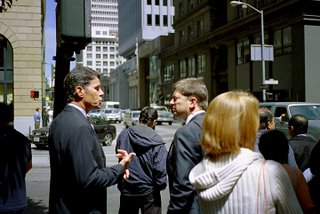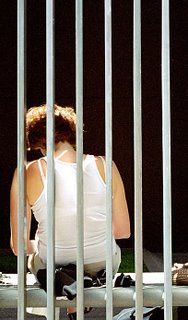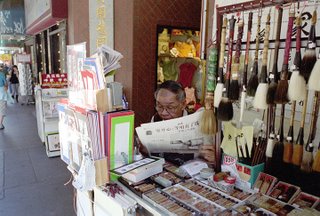Thursday, August 31, 2006
The Power of the Hip, part II
The direct approach entails seeing a moment, approaching it, intruding to make the photo and moving on. Photos made using the direct approach usually consist of images in which the subject(s) is looking directly into the camera, or where the subjects are obviously fully aware of the presence of the photographer. These are often very engaging images, because often we (the viewer) are looking into the eyes of the subject; we feel a part of the moment.
Photos made using the indirect approach, on the other hand, generally lack the engagement between subject and viewer. As viewers we feel we are looking in on the scene, almost as if we are invisible. There is sometimes a level of detachment, a sense of inaccessibility for the viewer, but that’s not necessarily a bad thing, nor is it always the case.
Both approaches are valid and the line between the two can be blurry, but I think the main point to consider as a photographer is how to confront the moment. Not every moment requires intervention by the photographer, some do, but some don’t. In either case the hip shot becomes a very valuable tool. A photographer skilled at using the hip shot can get very close to a scene and shoot without being detected, without interrupting the moment. Not being detected can mean getting off several shots, if need be, without (or before) being detected. It can mean capturing the truest or purest sense of the moment as it occurs, or working the scene to get a unique or descriptive angle. Something happens when the presence of a camera is detected, people change, situations change, so using the hip shot can mean getting closer to the moment and possibly capturing a truer sense of the moment.
This doesn’t mean that the hip shot is only useful with the indirect approach. It can be very useful with the direct approach, particularly if you’re using an SLR or rangefinder camera. With these types of cameras it can be useful as a means of keeping the camera away from the front of your face, which is off-putting to some people. Remember, that my definition of hip shot is any shot in which the photographer made the exposure without the camera at his or her face, without looking through the viewfinder. The first shot above of the Chinatown busker is a hip shot. The gentleman was seated playing his instrument. This fellow saw the camera and just stared into it.
To use the hip shot effectively means you have to know your gear. You have to know the coverage of the lens. You have to preset focus. You have to judge distances, judge exposure, etc. You have to be skilled at shooting, framing, and composing without looking through the viewfinder.
One of the toughest things about using the hip shot is making images that don’t look like hip shots, and that’s really the key. Your image shouldn’t scream “This a hip shot!” A big part of that is keeping the camera somewhat level. There are a lot of techniques and tools you can use, including using your camera’s strap (shoulder straps are great), and different parts of your body to keep the camera level. Experimentation and lots of shooting are really the only ways to build proficiency.
The hipshot is a technique that can allow you to capture the sense of a moment. It’s possible that when using the hip shot you may be able to capture a truer sense of the moment, because it allows you to shoot undetected. Regardless of the philosophy behind the hip shot, it is a useful technique that requires practice and experimentation. If you shoot on the street, the hip shot is a worthwhile technique to learn, a tool worth having.
Monday, August 28, 2006
The Power of the Hip
As a proponent of the hip shot, I was amazed when “discussion” on RFF sprang up around the technique, and it was proclaimed to be “cowardly.” I was surprised to see this statement receive support. I defended the technique, and will continue to defend it as a valuable tool that all photographers should be comfortable and adept at employing.
I think the main reason that some consider the hip shot to be cowardly is the impression that it is sneaky. The below-the-belt connotation seems to imply that the photographer is shy, tentative and unwilling. Unassertiveness is considered unattractive and weak. Whereas a shy, tentative photographer may be unwilling to confront a subject directly, and may employ the hipshot to “get the picture,” it isn’t a cowardly act at all—even in this context. After all, anybody who actually goes out and takes pictures of complete strangers is not a coward. You have to have some guts to get out there and even try it. It’s hard to do and in this sense using the hip shot is a great way for the beginner to build confidence (and for the seasoned street shooter to get warmed-up). For the beginning street shooter it can be a developmental technique, an aid that can assist in overcoming the fear of photographing strangers, and becoming a better photographer. However, whereas we can consider the hip shot to be a good technique for the beginner there is more to the hipshot than this “training wheel” approach to street shooting.
As a technique the hip shot can be a powerful tool that can open-up an entirely different approach to photography, one that allows the photographer to add a different dimension to their shooting and one that differs radically from the more traditional approach.
To Be Continued
Saturday, August 26, 2006
Some Recent Work

.

.

All three shots were made with a M4-P and a Cosina Voigtlander 35/2.5 lens.
Tuesday, August 15, 2006
Shot in the Back

I find it all pretty ridiculous. I haven't shot much on the street with anything greater than a 50mm lens, but if I need to, or want to, no rule is going to prevent me from doing so. Likewise, no rule will prevent me from shooting a subject from behind. I really like the feeling of such images. True these images are far less engaging—in the sense that nothing quite grabs a viewer's attention as much as an image with the subject staring directly back. However the quality of an image in which the subject is shot from behind is unique. There is a detachment, or a detached quality. The detachment seems to strip a layer of understanding from the viewing equation, forcing the viewer to derive meaning from the subject's surroundings. It's an odd phenomena. Without a human face, but with a human form, we seem to search for meaning, deriving it from whatever we can.
The first photograph that I can recall that distinctly and prominently featured a subject shot from behind, and the one that made a huge impact on me was an image created by Lisette Model. The photograph was of a large man, in a tight fitting t-shirt with thin horizontal stripes (sorry, I can't find this image online right now). The man wears a beret, and he is sitting on a bench. The subject fills about 80-90% of the frame . It is very simply an image of a large man shot from behind. It's an image I'll never forget having seen, yet I still don't know why it has had such an impact on me. Many photographers such as Joel Meyerowitz and Daido Moriyama have used this "technique," to create very memorable images, as well.
Damn the "rules"! Break the "rules"! Make your images.
Thursday, August 10, 2006
Critiques on RFF & Japanese Photographers
I've been shooting, primarily with my M4-P and the CV 35/2.5. I have 15 rolls of b&w in the processing queue, and about 3 rolls of color. I won't have the b&w processed for at least a couple of weeks, but the color I hope to have ready to scan by tomorrow evening.
I've found myself exploring Japanese photographers. A recent visit to the San Francisco MOMA resulted in a ~$80 purchase of two books. Daido Moriyama's Stray Dog, and Nobuyoshi Araki's Subway Love. I also broke free during lunch today to see the Shomei Tomatsu's Skin of a Nation exhibit at the SF MOMA. I was very impressed with the show. So, I'm getting a pretty good education on some established Japanese photographers, who I had very little familiarity with. If any of you would care to recommend others, please drop me a comment, or an e-mail.
As much as I love the Moriyama book, it's the Araki book that has me curious. I can't help comparing Subway Love to Walker Evan's Many Are Called. It's a fun comparison of basically the same project. Both books deal with photographing unaware subway riders over an extended period of time.
The Evans' book is a careful study, the result of ideology and thought. From all reports Evans' culled the best images based on exposure, and framing, cropping them for presentation. Araki on the other hand is much different. First of all, he gives you EVERYTHING, every shot regardless of how well it presents. It's a wild presentation full of blurred images, under-exposed and over-exposed shots, contact sheets, sprocket holes, etc. It's an expressionistic portrayal of life on the subway. It may be driven by an ideology as serious a Evans', but the end result looks much different.
I don't know the plans for the Tomatsu show after it leaves the SF MOMA after Sunday August 13. If it comes to your city check it out. The SF MOMA has a book that accompanies the show. I may end up getting the book, but viewing it at the MOMA, immediately after the show, I was unimpressed. His images are so stunning that the layout of the book and image quality paled in comparison.
I hope to have some images by the weekend, so check back if you get a chance. I hope you're enjoying the summer, if you're in the northern hemisphere, and the winter if your south of the equator.
.



